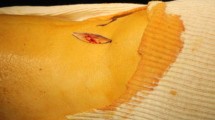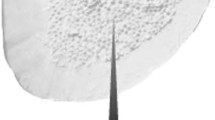Abstract
The results in 53 knees that had been treated by proximal tibial opening-wedge osteotomy for large varus deformity and osteoarthritis of the medial compartment were evaluated after a mean length of follow-up of ten years (range, 8–12 years). We used a porous beta-tricalcium phosphate (β-TCP) wedge because it is resorbable and osteoinductive. All osteotomies were completely consolidated and complete osseointegration of the remnant of the β-TCP wedge took place. However, after a mean maximum follow-up of ten years none of the cases showed complete resorption. After ten years, 40 (81%) of the 53 knees had an excellent or good result, and in 13 knees there was recurrent pain for which six had an arthroplasty. Although the results deteriorated with time, time was not the only determinant of the result. Alignment, measured as the hip-knee-ankle angle on radiographs of the whole limb that were made with the patient bearing weight, was also a determinant of long-term results. The best results were obtained in the knees that had a hip-knee-ankle angle of 183–186 degrees. In these knees, there was no pain and no progression of the arthrosis in either the medial or the lateral tibiofemoral compartment. Of the three knees that had an angle of more than 186 degrees, all five had progressive degenerative changes in the lateral compartment. In the undercorrected knees (an angle of less than 183 degrees), the results were less satisfactory, and there was a tendency toward recurrence of the varus deformity and progression of the arthritis of the medial compartment. However, when the correction was insufficient the deterioration was slow. Therefore, proximal tibial osteotomy is a very suitable operation even for patients who have gonarthrosis of the medial compartment and a large varus deformity. Although, a rigidly standardised and precise operative technique is required as well as accurate radiographic measurements of the mechanical axis of the limb because exact postoperative alignment is the prerequisite for the longest possible period of relief of symptoms after osteotomy, and this exact alignment is difficult to obtain for patients with large varus deformity.

Similar content being viewed by others
References
Dowd GS, Somayaji HS, Uthukuri M (2006) High tibial osteotomy for medial compartment osteoarthritis. Knee 13:87–92
Fujisawa Y, Masuhara K, Shiomi S (1979) The effect of high tibial osteotomy on osteoarthritis of the knee. An arthroscopic study of 54 knee joints. Orthop Clin North Am 210:585–588
Gaasbeek RD, Sonneveld H, van Heerwaarden RJ, Jacobs WC, Wymenga AB (2004) Distal tuberosity osteotomy in open wedge high tibial osteotomy can prevent patella infera: a new technique. Knee 11:457–461
Grelsamer RP (1995) Unicompartmental osteoarthritis of the knee. J Bone Jt Surg [Am] 77:278–281
Hernigou P, Medevielle D, Debeyre J, Goutallier D (1987) Proximal tibial osteotomy for osteoarthritis with varus deformity. J Bone Jt Surg [Am] 69:332–354
Goulet JA, Senunas LE, DeSilva GL, Greenfield ML (1997) Autogenous iliac crest bone graft. Complications and functional assessment. Clin Orthop Relat Res 339:76–81
Hernigou P, Ovadia H, Goutallier D (1992) Modélisation mathématique de l'ostéotomie tibiale d'ouverture et table de correction. Revue de Chirurgie Orthopédique 78:258–263
Hernigou P, Ma W (2001) Open wedge tibial osteotomy with acrylic bone cement as bone substitute. Knee 8:103–110
Hernigou P (2002) Open wedge tibial osteotomy: combined coronal and sagittal correction. Knee 9:15–20
Bignon A, Chouteau J, Chevalier J, Fantozzi G, Carret JP, Chavassieux P et al (2003) Effect of micro- and macroporosity of bone substitutes on their mechanical properties and cellular response. J Mater Sci Mater Med 14:1089–1097
Hirata M, Murata H, Takeshita H, Sakabe T, Tsuji Y, Kubo T (2006) Use of purified beta-tricalcium phosphate for filling defects after curettage of benign bone tumours. Int Orthop 30:510–513
Sarkar MR, Wachter N, Patka P, Kinzl L (2001) First histological observations on the incorporation of a novel calcium phosphate bone substitute material in human cancellous bone. J Biomed Mater Res 58:329–334
Schilling AF, LinhartW FS, Gebauer M, Schinke T, Rueger JM et al (2004) Resorbability of bone substitute biomaterials by human osteoclasts. Biomaterials 25:3963–3972
Ahlback S (1968) Osteoarthrosis of the knee. A radiographic investigation. Acta Radiol Diagn (Stockh) (Suppl 72):1–21
van Hemert WL, Willems K, Anderson PG, van Heerwaarden RJ, Wymenga AB (2004) Tricalcium phosphate granules or rigid wedge preforms in open wedge high tibial osteotomy: a radiological study with a new evaluation system. Knee 11:451–456
Lobenhoffer P, Agneskirchner JD (2003) Improvements in surgical technique of valgus high tibial osteotomy. Knee Surg Sports Traumatol Arthrosc 11:132–138
Murphy SB (1994) Tibial osteotomy for genu varum. Indications, preoperative planning, and technique. Orthop Clin North Am 25:477–482
Dehoux E, Madi K, Fourati E, Mensa C, Segal P (2005) High tibial open-wedge osteotomy using a tricalcium phosphate substitute: 70 cases with 18 months mean follow-up. Rev Chir Orthop Repar Appar Mot 91:143–148
Bonnevialle P, Abid A, Mansat P, Verhaeghe L, Clement D, Mansat M (2002) Tibial valgus osteotomy using a tricalcium phosphate medial wedge: a minimally invasive technique. Rev Chir Orthop Repar Appar Mot 88:486–492
Tunggal JAW, Higgins GA, Waddell JP (2009) Complications of closing wedge high tibial osteotomy. Int Orthop. doi:10.1007/s00264-009-0819-9
Nelissen EM, van Langelaan EJ, Nelissen RG (2009) Stability of medial opening wedge high tibial osteotomy: a failure analysis. Int Orthop. doi:10.1007/s00264-009-0723-3
Author information
Authors and Affiliations
Corresponding author
Rights and permissions
About this article
Cite this article
Hernigou, P., Roussignol, X., Flouzat-Lachaniette, C.H. et al. Opening wedge tibial osteotomy for large varus deformity with CeraverTM resorbable beta tricalcium phosphate wedges. International Orthopaedics (SICOT) 34, 191–199 (2010). https://doi.org/10.1007/s00264-009-0875-1
Received:
Revised:
Accepted:
Published:
Issue Date:
DOI: https://doi.org/10.1007/s00264-009-0875-1




